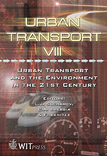A City And A Transport System For A Mutual Enrichment
Price
Free (open access)
Transaction
Volume
60
Pages
9
Published
2002
Size
465 kb
Paper DOI
10.2495/UT020121
Copyright
WIT Press
Author(s)
P. Vuaillat, D. Bouchet & J.-P. Berger
Abstract
Recent experiences in European cities and, increasingly, even on the other side of the Atlantic (Portland, Dallas, Sacramento, etc.) where, the joyfulness of the streets does not have the same meaning as in the Old World, have shown that the success of a transport project cannot be dissociated from the re-conquering of public space to the advantage of pedestrians. In middle sized cities, where travelling times are comparatively short, the amount of walking in an individual journey chain (arrival walk – transportation - final walk) is as important as the time spent on public transport itself. Travelling on public transport can thus be a time for pedestrians to sit back and relax, between two \“arrival walks”. Willing users of public transport become city-walking enthusiasts, people who love strolling around. This \“quality of life”, which increasing numbers of city-dwellers are seeking, does not arrive on a plate. It has to be conquered and the enjoyable journeys it offers you will be your reward. Even sceptics will be won over. They will acquire a taste for the enjoyment to be found. Now the two components which make this travel chain so attractive are both complementary and interactive. The new lay-out of public places (streets, squares and places for social interaction), as part of a modem public transport project, affects the speed and comfort of the form of transport itself (a key factor in its attractiveness) as well as the quality of station accessibility (another key factor). In other words, we would have little chance of attracting (and keeping) customers on urban public transport by creating a remarkable and rapid fixed link through areas which are \“inhospitable” to pedestrians (car saturation, uncomfortable and inaccessible stations, poor connections etc.). Conversely, we would have no more success in restricting ourselves to designing high quality public spaces without an efficient transport system to accompany them. In urban public transport the attractiveness of the environment and operational efficiency are not mutually exclusive - each is a guarantee of the others quality.
Keywords





